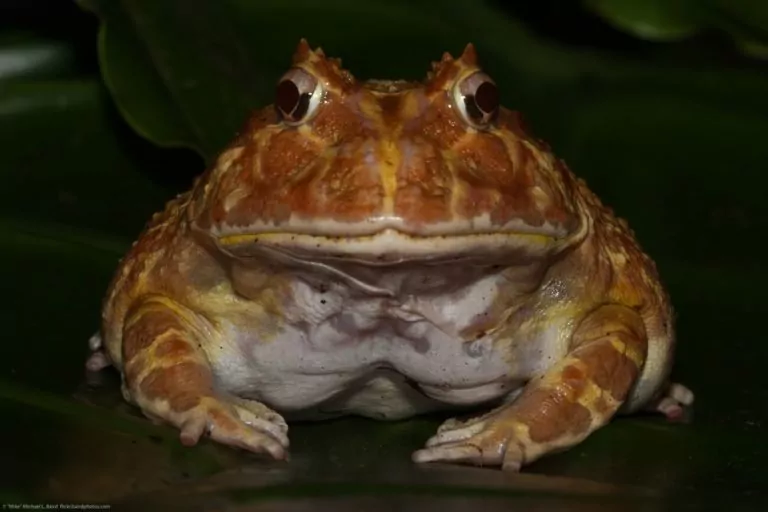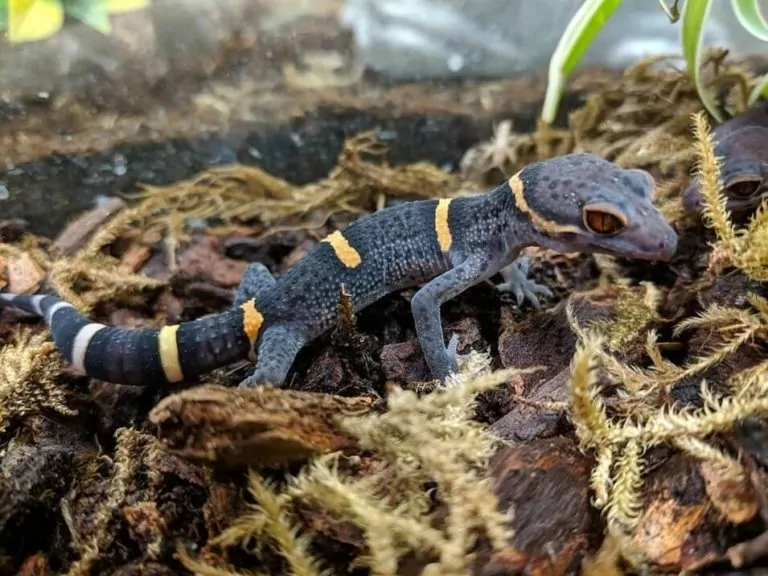Satanic leaf-tailed geckos are fascinating-looking reptiles that stand out (or blend in) anywhere. Trust us, these creatures are like nothing you’ve ever seen!
Because of their unique appearance, there’s a lot of interest in owning them as pets. But doing this properly requires experience and commitment.
This guide will teach you all about satanic leaf-tailed gecko care, to give you an idea of the work required. In addition to care requirements, you’ll also learn some interesting facts about this beautiful reptile!
Table of Contents
Species Summary
The satanic leaf-tailed gecko (Uroplatus phantasticus) can be found in the mountainous rainforest areas of coastal eastern Madagascar. Other names associated with this gecko are phantastic leaf-tailed gecko and eyelash leaf-tailed gecko.
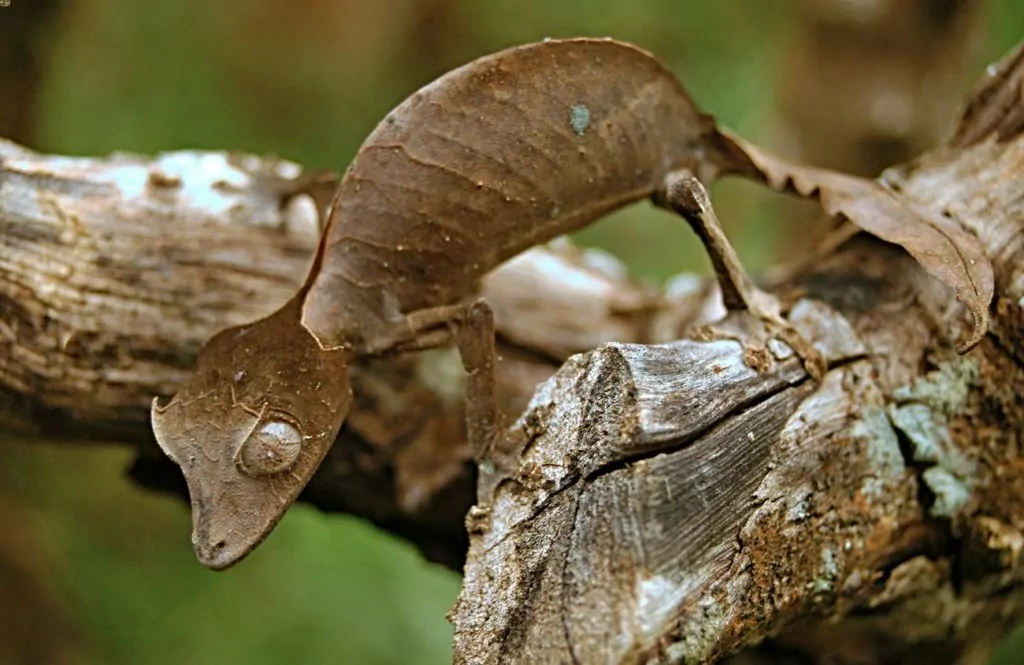
You may be wondering why this little gecko species has such a scary sounding name. The name was chosen due to its odd appearance. Perhaps, at first, this gecko may look a bit strange, but we think it’s actually quite cute on closer inspection!
This adorable little gecko is highly prized by reptile aficionados for its unique appearance and shy demeanor. Because the satanic leaf-tailed gecko has very specific husbandry requirements, we rate this pet reptile as being appropriate for advanced reptile owners only.
Appearance & Colors
The satanic leaf-tailed gecko belongs to a group of three Madagascar geckos that all have bodies that resemble dead leaves. With a body coloring that can range from orange to tan to brown, this little gecko has the ability to blend in perfectly with leaf litter.
If your satanic leaf-tailed gecko is feeling stressed or if there is a change in the environment, it has a limited ability to change color in response. This is a behavior that is similar to chameleons and other types of lizards.
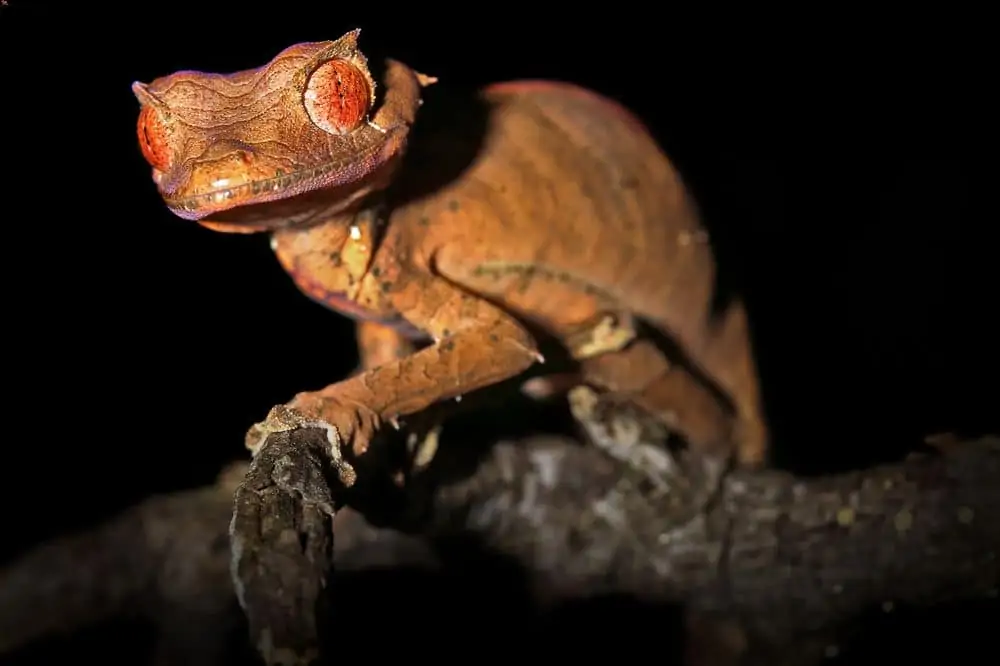
Take a good look at the body of the satanic leaf-tailed gecko, and you will see markings on the skin that look like leaf veins, a curved body that mimics the edge of a leaf, and a tail that is the perfect imitation of a dead leaf. In fact, this is the feature that inspired part of its name.
Because this species is sexually dimorphic (meaning that males and females have slightly different characteristics) the tail of the female looks more like a fresh leaf.
Expert Tip: Males have a hemipenal bulge that is fully developed by the time it is about six months old. This is yet another example of the dimorphism found in this gecko species.
Lifespan
The typical satanic leaf-tailed gecko lifespan is around ten years in captivity (sometimes slightly longer).
This assumes that they’re living in a carefully monitored enclosure with a nutritious diet. Failing to provide them with these fundamental care requirements will lead to a much shorter lifespan.
Average Size
The average satanic leaf-tailed gecko size is usually between 2.5 and 3.5 inches when fully grown. This measurement includes the tail.
Expert Tip: Compared to other gecko species, the satanic leaf-tailed gecko is considered to be on the smaller side. You’ll notice that males are ever so slightly larger than females, but it’s rather hard to notice.
Satanic Leaf-Tailed Gecko Care
As mentioned above, satanic leaf-tailed gecko care is a task that’s best suited for owners with an advanced knowledge of reptile husbandry.
Caring for a satanic leaf-tailed gecko requires a closely monitored temperature, a specific humidity level, a proper diet, and carefully planned enclosure enhancements.
In addition to meeting all of the above requirements, you’ll also need to commit to leaving this shy gecko to simply live its life without a lot of handling or disturbance.
Enclosure Size
A single satanic leaf-tailed gecko can be comfortably housed in a 10 inch x 10 inch x 20 inch enclosure. If you’re planning to house a breeding pair or three geckos together, we suggest bumping up the size of the enclosure to 12 inches x 16 inches x 20 inches.
It is certainly fine to use an enclosure that is larger, but you should make sure that any enclosure has more vertical space than horizontal space.
As far as the type of enclosure goes, there are many acceptable options. You can use a glass tank, an enclosure with screens, or even a plastic bin. We like glass enclosures because they let you easily observe your satanic leaf-tailed gecko.
Setting Up Their Habitat
The same way that you would fill your living space with items that make you feel comfortable and at home, you’ll want to create an enclosure that will give your satanic leaf-tailed gecko the same kind of familiar vibes.
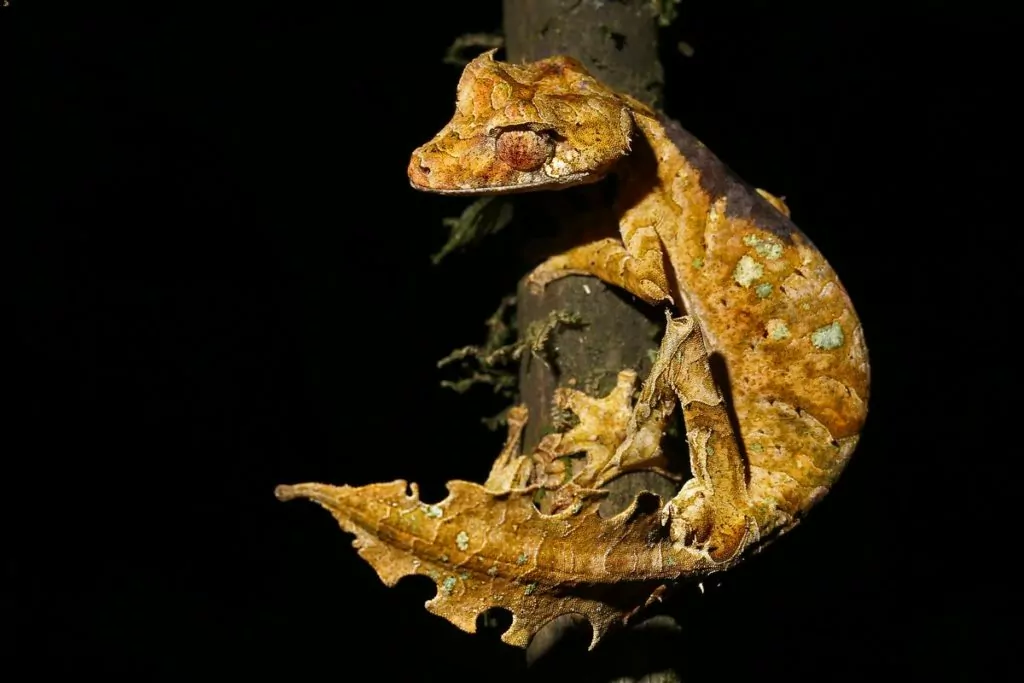
When you’re setting up the enclosure, it’s best to begin with the substrate.
A substrate is the stuff that goes in the bottom of the enclosure. Sphagnum moss or peat moss both work well because they will hold in the moisture that creates the humid environment your gecko needs.
Because your gecko’s natural habitat is a tropical forest environment, putting lots of plants in the enclosure is going to make your pet very happy. We highly suggest putting live plants like ficus, golden pothos, bromeliads or dracaena into the enclosure. You can also add bendy vine for added climbing and hiding options.
Expert Tip: Always make sure that you check a list of acceptable plants first. Your gecko may take a nibble or two, and some plants can be very toxic.
Your gecko will also enjoy other enhancements like small logs and branches or even small reptile hides.
Temperature & Lighting
Unlike some other pet reptiles, the satanic leaf-tailed gecko likes temperatures that run on the cooler side.
You will need to keep the ambient temperature within the tank at 72-78 degrees Fahrenheit, and nighttime temperatures can go as low as 60-65 degrees Fahrenheit.
Installing a thermometer in the enclosure will help you make sure the tank is at the correct temperature at all times. We recommend using an incandescent light or a ceramic heater to maintain the proper ambient heat as well.
As far as lighting in the enclosure goes, this gecko does not really need a basking area, so you won’t need to install a basking light. However, you should be operating your lighting on a 12 hours on, 12 hours off schedule.
Some people say that providing extra UVB lighting is necessary, but it’s really a matter of choice. Adding a UVB bulb to the enclosure certainly won’t do any harm, and your satanic leaf-tailed gecko will be getting an added boost of helpful UVB light.
Humidity
Your satanic leaf-tailed gecko will require a high level of humidity in the enclosure. In fact, the humidity should remain between 70 and 85 percent.
Misting the enclosure before you turn the lights out for the night should be enough. It’s very important to make sure that the enclosure is moist, not wet (you don’t want mold or mildew to form).
Expert Tip: Misting with a hand-held mister should be fine, but some people prefer to install an automatic mister. Either way is perfectly acceptable.
Water
Your satanic leaf-tailed gecko is going to get all the water it needs from the droplets that form after misting. They will drink water droplets from plants, the substrate, or the side of the tank.
Always make sure that the water you use is chlorine-free and that it is neither too hot nor too cold.
Food & Diet
Diet is a crucial part of satanic leaf-tailed gecko care, and will be a key factor in the health and longevity of your pet.
Being an insectivore, your gecko will need a diet of insects such as crickets, spiders, flies, cockroaches and snails. Whichever combination you opt for, make sure that it is never wider than the gecko’s neck.
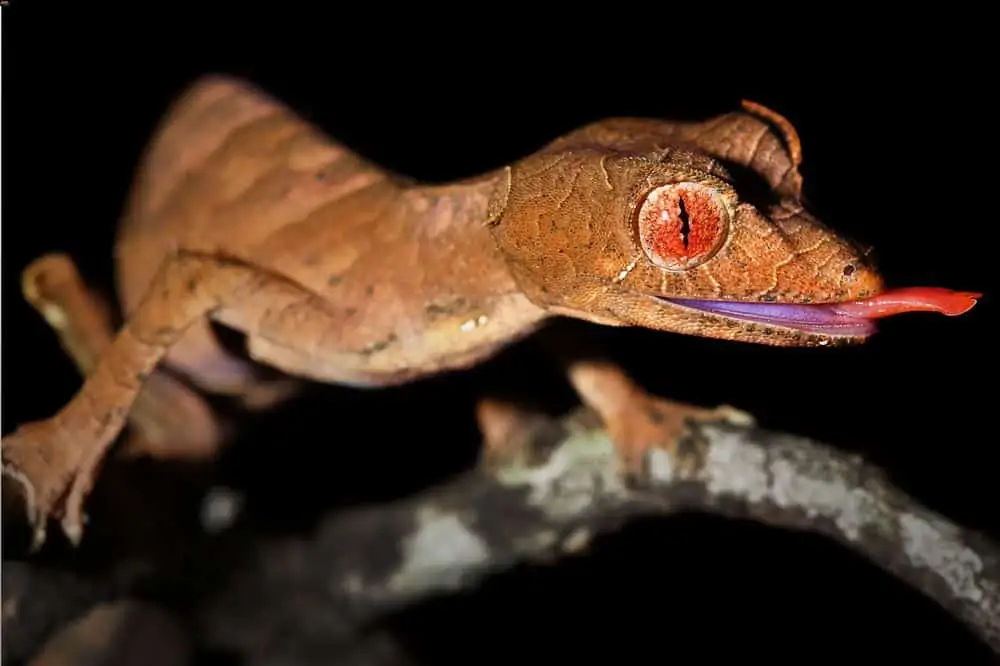
Even if you gut load the food, it’s still going to be important to use a supplemental dusting powder prior to feeding time. This will help to ensure that your satanic leaf-tailed gecko is getting all of the nutrients that it needs.
Expert Tip: Your gecko is going to be happiest if it can catch live prey rather than just eating prey that’s already dead. If you put live crickets in the enclosure every couple of days, this should be fine.
You definitely don’t want to overfeed your pet, so put in enough feeders to last a few days. It may take a while to figure out how many to put in at feeding time, but learning from trial and error is totally fine.
Potential Health Complications
Being a responsible pet owner means that the health and well-being of your satanic leaf-tailed gecko should always be a top priority. There are a number of health issues to be aware of, and they include:
Humidity: An environment that is too wet or too dry can lead to problems with shedding or problems that come from mold or mildew build-up.
Stress: This can be a real problem for satanic leaf-tailed geckos. Too much handling, an unsuitable environment or misting with cold water can lead to dangerous amounts of stress.
Mites and parasites: Both can really plague your satanic leaf-tailed gecko, so make sure their enclosure is clean, and bring them to the vet regularly for fecal testing.
MBD: Metabolic bone disease can be an issue, but if you dust the prey with a supplement powder, this should not become a problem.
Lethargy, lack of appetite, changes in skin condition or discharge from the eyes or nose can be signs of serious illness. Take your pet to the veterinarian right away if you suspect health problems.
Behavior & Temperament
The satanic leaf-tailed gecko is a shy reptile that does not like to be handled. It prefers to climb and hide, and it is happiest if left alone.
If you notice that your satanic leaf-tailed gecko is licking its eyeballs, don’t worry. This is perfectly normal (but slightly gross) behavior. Since these geckos don’t have eyelids, they will lick their eyeballs to clean off dirt or dust!
These geckos are very slow movers and climbers. You won’t see them running around the tank as with some other lizards. In fact, quick movements could be a sign of illness.
Close observation will show you that these lizards communicate with their tails. It can signal stress, aggression or a readiness to mate just by using special tail movements.
You may also hear a humming or barking sort of sound coming from your satanic leaf-tailed gecko. This is all perfectly normal, and these sounds are used to communicate with other geckos.
Lastly, your satanic leaf-tailed gecko is very good at vertical climbing. They use tiny little hairs on their toe pads as well as their claws to help them climb just about anything.
Handling Them
As mentioned above, satanic leaf-tailed geckos do not like to be handled. They are very happy to be left alone to enjoy the comfortable and safe environment that you create for them. Any handling should be kept to an absolute minimum.
These adorable little reptiles are lots of fun to watch, so let your gecko do what geckos do, and enjoy the show!
Conclusion
Satanic leaf-tailed gecko care is not for beginners. Due to their unique conditions and nervous temperament, we highly recommend that you acquire some experience before owning one.
But trust us, owning one is definitely worth the effort. These incredibly unique reptiles are a joy to observe. It never gets old!
If you have any questions that we didn’t address in this care guide, don’t hesitate to ask!

